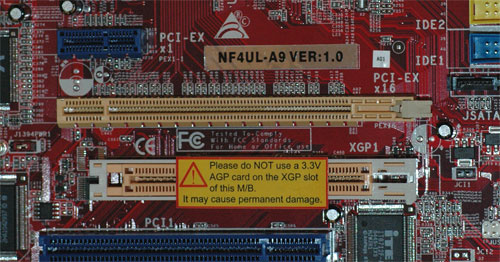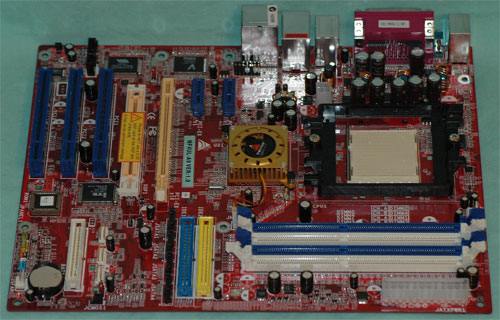nForce4 Ultra Roundup: Charting the Mainstream
by Wesley Fink on July 5, 2005 10:28 PM EST- Posted in
- Motherboards
Biostar NF4UL-A9: Features and Layout
| Specification | Biostar NF4UL-A9 |
| CPU Interface | Socket 939 Athlon 64 |
| Chipset | nForce4 Ultra (single chip) |
| BUS Speeds | 200MHz to 300MHz (in 1MHz increments) |
| PCI/AGP Speeds | Asynchronous (Fixed) |
| PCI Express | Fixed |
| Core Voltage | Startup, 1.2V to 1.625V in 0.025V increments |
| DRAM Voltage | Default, 2.7V, 2.8V, 2.9V |
| Chipset Voltage | NA |
| Hyper Transport Ratios | Auto, 1x, 2x, 3x, 4x, 5x |
| LDT Bus Transfer | 16/16, 16/8, 8/16, 8/8 |
| CPU Ratios | Startup, 4x to 25x in 1x increments |
| DRAM Speeds | Auto, 100, 133, 166, 200 |
| Memory Command Rate | Auto, 1T, 2T |
| Memory Slots | Four 184-pin DDR Dual-Channel Slots Unbuffered ECC or non-ECC Memory to 4GB Total |
| Expansion Slots | 1 x16 PCIe Slots 1 Xtreme Graphics Port (AGP 8X Form Factor) 2 x1 PCIe 3 PCI Slots |
| Onboard SATA | 4-Drive SATA 2 by nF4 |
| Onboard IDE | Two Standard NVIDIA ATA133/100/66 (4 drives) |
| SATA/IDE RAID | 4-Drive SATA 2 PLUS 4-Drive IDE (8 total) Can be combined in RAID 0, 1 |
| Onboard USB 2.0/IEEE-1394 | 10 USB 2.0 ports supported nF4 2 1394A FireWire ports by VIA VT6307 |
| Onboard LAN | Gigabit PCIe Ethernet by Vitesse VXC8201 PHY |
| Onboard Audio | Realtek ALC850 8-Channel codec with 6 UAJ audio jacks, CD-in, front audio, and optional coaxial SPDIF cable |
| Other Features | Dual-Core (x2) Support with BIOS nf4ua614 |
| BIOS | nf4ua614 |
Biostar took a different approach in the design of their nForce4 Ultra board. If you look closely at the video card slots, you will see how unique this board really is.

Even though it is not a full 8X AGP slot, the Biostar is still a unique and useful choice for those having AGP cards that they are not ready to replace. Those buyers can go to the Biostar with their current AGP card and still have the option of moving to PCIe on the same board at some time in the future. Since nForce4 does not support AGP, the Biostar allows AGP users to choose an nForce4 board anyway.
The Biostar is basically a sound board layout, particularly for a lower-priced nF4 motherboard. The 4-pin 12V power connector requires snaking the 4-pin power cable over or around the CPU, a design that many others also use. The board edge is a better location, and fortunately, the 24-pin ATX cable does reside on a board edge where it belongs. The 4 SATA connectors are a tight fit next to the PCIe slot, but they will work - even with a very long PCIe video card with dual power connectors.
The floppy connector is on the lower right edge of the board, which is certainly a better location than the bottom of the board, but still a longer reach than the preferred upper right location. Turning the IDE connectors sideways allows them to fit on the right edge near the center of the board. In most case designs, this will work fine, but a tall case with drives above the board chamber might require snaking IDE cables over DIMMs - not ideal for air flow.
BIOS controls on the Biostar were a pleasant surprise for an entry-level nForce4 Ultra motherboard. Just about every adjustment that you need for overclocking is here, including a useful vDIMM range to 2.9V, a wide CPU voltage adjustment range, and CPU ratio adjustments. The same goes for features, as our board even had dual Firewire ports controlled by a TI controller. Firewire is one of the first options to go when manufacturers build to a price point.
The only glaring omission is the lack of a standard SPDIF optical or coaxial out port. A board with 8-channel sound and 6 jacks should have a supplied SPDIF connector, not an optional feature.
We also ran into a very strange anomaly when benchmarking the XGP graphics slot. When we mounted an 8X AGP card and selected PCI as out boot video, the system booted just fine into Windows XP. However, the Gigabit LAN had mysteriously disappeared and no amount of searching for new devices would bring it back. We removed the AGP and reinstalled a PCIe video card and the Gigabit LAN was back. We hope that Biostar can find a way to correct this strange behavior in a future BIOS update.
Abit Fatal1ty AN8: Overclocking and Stress Testing
Biostar NF4UL-A9: Overclocking and Stress Testing











75 Comments
View All Comments
yacoub - Wednesday, July 6, 2005 - link
#33 - Wesley, that's awesome news. Can you post that somewhere more important so buyers know to be on the lookout for it? =)kyparrish - Wednesday, July 6, 2005 - link
Good article!I'm seriously considering dumping my DFI S754/NC 3200+ setup for that Epox board and a cheap S939 A64 :)
Wesley Fink - Wednesday, July 6, 2005 - link
#29 and #31 - UPDATE: I have talked with contacts in the Memory Industry and Samsung TCCD is now available again from Samsung. TCCD disappeared for a few months but production didn't really stop. TCC5 is DDR466 and TCCD is DDR500, but both chips come off the same line and are binned for speed grade. Samsung stopped binning for DDR500 grade until recently - and left this job to the memory makers.Recently Samsung has told memory makers they are binning once again for DDR500/TCCD and the TCCD chips are available again. It will take a few weeks for the pipelines to fill but TCCD is not dead. Some companies are staying with TCC5 at a lower cost and binning for the top performance unless the yields start to go down.
Wesley Fink - Wednesday, July 6, 2005 - link
#24 - The base nForce4 is sometimes called the nForce4 X4 and runs at 800 HTT, while the Ultra and SLI run at 1000HT. When 1000HT was first introduced we found no real difference in performance at 800HT and 1000HT. What the 1000HT did provide was quite a bit more overclocking headroom. A reader may have an example of where 1000HT outperforms 800HT but the real world difference is negligible.#28 - There are now more than 60 BIOS releases for the DFI nF4, many customized for particular memory types. Only 3 have been posted to their website. For the latest DFI nF4 BIOS a good place to check is www.xtremesystems.org or the BIOS Files Forum at www.bleedinedge.com. There is now a 7/04 BIOS that is reported to be more stable in upper memory ratios (433,466,500) with Rev. E chips.
#29 - You are overstating the TCCD situation. Corsair still sells TCCD, as do several other memory vendors. There is no doubt TCCD is drying up everywhere but Corsair, and that will continue. New TCC5 dimms that are said to perform like TCCD are in process in at least one memory company. We have requested these new TCC5-based dimms and will share our findings as soon as we receive the memory. There are also some new BH5 dimms that we thought were gone forever. We have even seen the new BH5 binned and advertised as DDR500 2-2-2 at higher voltages around 3.3V.
yacoub - Wednesday, July 6, 2005 - link
Well, while this review -has- convinced me to go with the DFI board over the Chaintech, that is purely due to the audio CPU usage issues of the onboard vs daughterboard. I'm shocked at how much difference that makes.That said, most of the memory testing (and thus most of the review) was meaningless to me (and everyone else who doesn't have access to TCCD memory anymore). =/
Wesley Fink - Wednesday, July 6, 2005 - link
#17 - Thanks for pointing out the errors. They have been corrected. Do you want a job proof reading :-)yacoub - Wednesday, July 6, 2005 - link
Regarding the tRAS recommendation:Can we petition Anandtech to stop using memory that the consumer can't get anymore? (Namely TCCD-based Plat Rev2.) Go pick up some TCC5 and do your tests with what the consumer is actually going to be receiving so your tests actually mean something.
mongoosesRawesome - Wednesday, July 6, 2005 - link
What BIOS version did you use with the DFI? It reads: "Award 7/01/2005 Release" in your list of features for the DFI, but I could not find that BIOS release on their website.AsiLuc - Wednesday, July 6, 2005 - link
Sorry I meant: GA-K8NF9http://www.giga-byte.com/MotherBoard/Products/Prod...
AsiLuc - Wednesday, July 6, 2005 - link
I'd liked to see the Gigabyte GA-K8NP9 reviewed, because it has passive southbridge cooling (silence :) ) and is cheap.